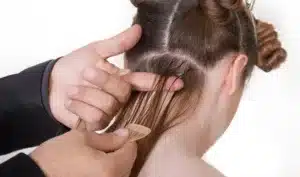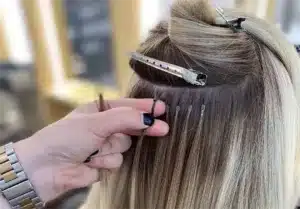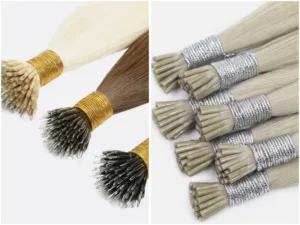If you’re wearing hair extensions, you probably want to know how long they’ll last before needing to be replaced. The truth is, the lifespan of your extensions depends on several factors, from the quality of the hair to how well you care for them. Let’s dive into the different reasons why your extensions may need replacing and how to get the most out of them.
Hair extensions should be replaced based on hair quality, daily care, and wear patterns. With proper care,Full cuticle hair can last 12-18months, Remy lasts 3–5 months, and non-Remy lasts 1–2 months. Hair extensions move-ups are needed every 6–10 weeks, depending on different methods and natural hair growth.

Healthy results come from predictable move-up cycles and smart replacement timing. I explain the signs, habits, and schedules that salons use to avoid damage and protect client satisfaction.
How Often Should Hair Extensions Be Moved Up?
Clients often ask how often do extensions need to be moved up or how often do hair extensions need to be moved up. The answer depends on the system, but move-ups fall into a simple 6–10 week cycle for most methods.
1. Tape-In Extensions
Move-Up Frequency: Every 6-8 weeks
Tape-ins need to be moved up every 6-8 weeks as the natural hair grows. The adhesive used to secure tape-in extensions weakens over time, so reapplication is necessary to prevent slippage.
Signs it’s time to move up:
Extensions start to feel loose.
Tape bonds begin to show or feel uncomfortable.

2. Clip-In Extensions
Move-Up Frequency: No move-up required
Since clip-ins are temporary, there’s no need to move them up. However, proper storage and care are key to maintaining them for long-term use. With proper care, clip-ins can last for up to 6 months to a year.

3. Keratin Bond (Fusion) Extensions
Move-Up Frequency: Every 3-4 months
Fusion extensions will need to be moved up every 3-4 months. As your natural hair grows, the bonds will shift, making reapplication necessary to keep them looking seamless.
Signs it’s time to move up:
The bonds are visibly loose or moving.
Extensions feel heavy and uncomfortable.
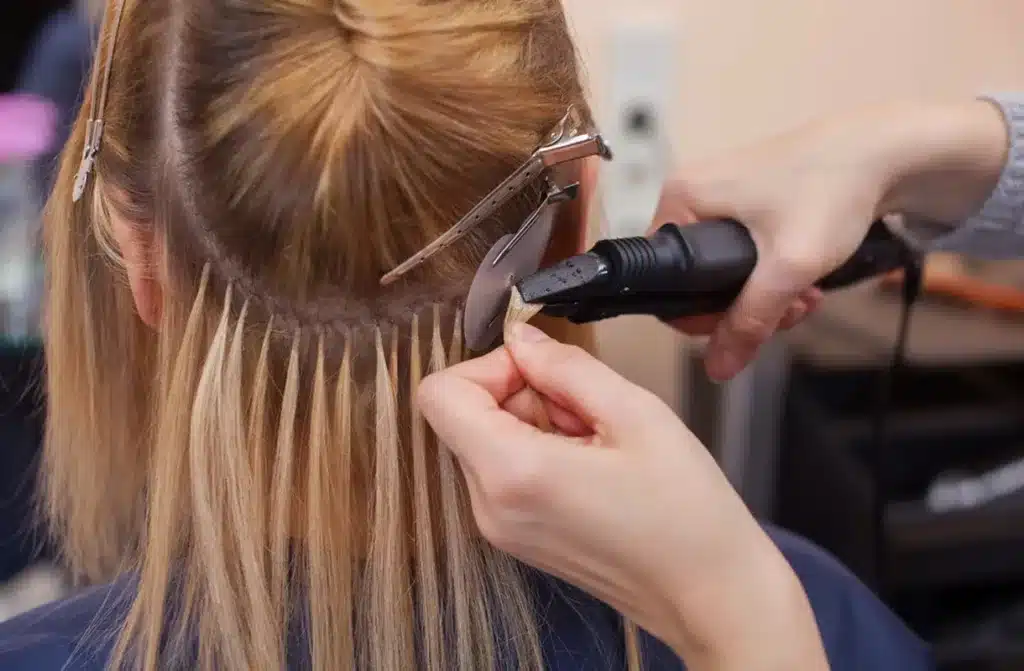
4. Sewn-In Wefts
Move-Up Frequency: Every 6-8 weeks
Sewn-in extensions also need to be moved up every 6-8 weeks due to natural hair growth. Over time, the threads may loosen, so a touch-up is needed to maintain the hairstyle.

5. Micro Bead Extensions
Move-Up Frequency: Every 6-8 weeks
Micro bead extensions need to be moved up about every 6-8 weeks. As your natural hair grows, the beads will shift down the shaft of your natural hair, requiring repositioning to keep them looking natural.

How Often Do Hair Extensions Need to Be Replaced?
Replacement depends on many factors, like hair material quality, extension method, and daily care. Material is the most important factor because cuticle structure decides how long the fiber can stay soft, smooth, and reusable.
1.hair Quality
Full Cuticle Hair
Lifespan: 12-18months with proper care
Full cuticle hair is considered the best quality because the cuticles are intact and aligned in the same direction. With proper care, this type of hair can last up to 12-18months. It’s more durable and resistant to tangling compared to lower-quality options, which is why it’s often used in premium extensions.
Signs it’s time to replace:
Significant shedding.
Hair becomes harder to style or manage.
Tangling or matting occurs despite care.

Remy Hair
Lifespan: 4-5 months with proper care
Remy hair has cuticles that are still intact, and the hair strands are aligned in the same direction. However, over time, the hair will begin to lose its original shine and texture. With proper care, Remy hair extensions can last around 4-6 months.
Signs it’s time to replace:
Hair becomes frizzy and difficult to style.
Hair sheds more than usual.
The hair no longer blends seamlessly with your natural hair.

Non-Remy Hair
Lifespan: 1-2 months with proper care
Non-Remy hair is of lower quality compared to Remy or full cuticle hair. The cuticles may be stripped or damaged, and the hair strands are not aligned in the same direction. Non-Remy hair typically lasts around 1-3 months with proper care, but it can quickly lose its smoothness and shine.
Signs it’s time to replace:
Tangling and matting become more frequent.
Hair loses softness and natural shine.
Hair becomes brittle or difficult to manage.
2.hair Extension Type
The method used to install your extensions will impact how often they need to be replaced or moved up.
Tape-In Extensions: Need to be moved up every 6-8 weeks as your natural hair grows. The tape can weaken over time, but the hair can last for several months if well-maintained.
Clip-In Extensions: These are temporary extensions that don’t require “move-ups.” You can wear them as often as you like, but with proper care, clip-ins can last up to 6 months to a year.
Keratin Bond (Fusion) Extensions: These need to be moved up every 3-4 months as the bonds can loosen with natural hair growth.
Sewn-In (Weft) Extensions: Wefts can last several months before needing to be repositioned, but they typically need to be moved up every 6-8 weeks.
Micro Bead (Micro Link) Extensions: These extensions are moved up every 6-8 weeks, similar to tape-in extensions.
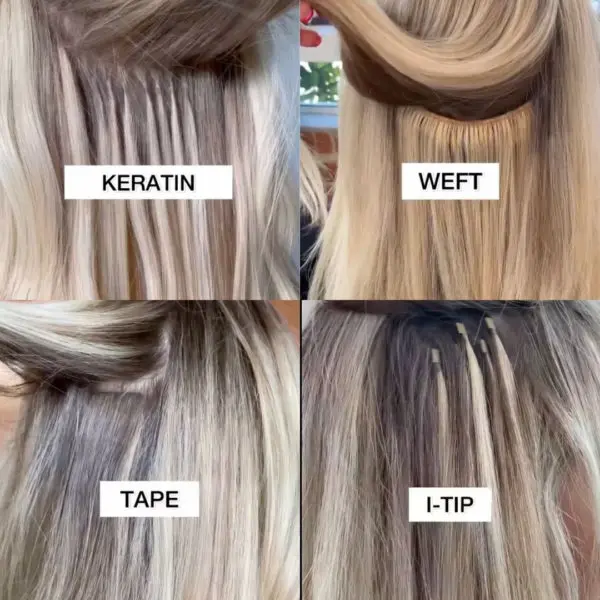
3.Hair Care Routine
Proper care is crucial to extending the lifespan of your extensions. Here’s what you should do:
Wash and Condition Gently: Use sulfate-free shampoos and conditioners to avoid stripping moisture. Over-washing can lead to tangling and drying out the hair.
Minimize Heat Styling: Excessive heat can damage extensions, causing them to lose their smoothness and shine. Always use a heat protectant spray if you must use styling tools.
Detangle Properly: Brush your extensions gently with a wide-tooth comb or a special extension brush to avoid shedding and tangling.
Moisturize Regularly: Keep the extensions moisturized with oils or leave-in conditioners to prevent dryness, which can cause breakage and tangling.

4.Installation Method
How your extensions are installed can make a huge difference in their longevity. Improper installation or tightness can lead to hair breakage or early shedding. Always seek a professional stylist to install or move up your extensions to ensure the bonds or attachments are secure without causing damage.
Tape-In Extensions: Ensure the tape is applied properly and not too close to the scalp to avoid discomfort or damage to natural hair.
Fusion Extensions: Improper fusion bonding can cause discomfort, shedding, or even damage to your natural hair, so make sure a professional stylist installs these.
Sew-In Wefts: If not sewn in properly, the wefts can loosen and shift, causing discomfort and premature wear.
What Are the Signs That It’s Time to Replace Hair Extensions?
Hair extensions send clear signals when their lifespan is ending. These signs show that the fiber structure can no longer recover after washing, treatments, and trims.
Common signs include tangling, dryness, split ends, frizzy texture, or color that no longer tones correctly. Slippage, matting at the row, or persistent odor after cleansing also mean the extensions are past their cycle.
Visible Indicators
- Tangles returning within hours after brushing
- Ends becoming stiff, squeaky, or hollow
- White fuzz or frayed ends
- Slippage that repeats after tightening
- Odor that stays after clarifying
- Brassiness that returns quickly
If treatments, trims, and resets no longer restore the hair, replacement is needed.
Which Daily Habits Shorten Extension Lifespan?
Small daily habits influence wear far more than clients expect. Sweat, friction, and product choices all affect longevity.
Sleeping with wet hair, using heavy oils near the roots, or applying heat too close to bonds reduces lifespan. Skipping brushing or not rinsing after swimming also accelerates dryness and matting.
Habits That Break Down Extensions Faster
- Sleeping with damp hair → matting
- Oil and silicone near bonds → slippage
- No rinse after swim → chlorine damage
- Daily 400°F heat → split ends and dryness
- Rare brushing → knots at nape
- Cotton pillowcases → friction
Changing these habits adds months to the lifespan of extensions.
How Do We Maintain Extensions to Prolong Life?
Consistent maintenance is the easiest way to double extension lifespan. Healthy extensions follow a simple pattern: gentle cleansing, controlled moisture, heat safety, and clean move-up cycles.
Stylists schedule move-ups every 6–10 weeks, depending on method and natural growth. Regular trims, clarifying washes, and proper drying at the roots prevent build-up and fiber fatigue.
Maintenance System
Daily
- Brush 2–3 times
- Keep hair dry before bed
- Use a silk pillowcase
- Apply heat protectant
Weekly
- Wash 1–2 times
- Condition mids–ends
- Clarify when needed
- Dry roots completely
Service Cycle
- Move-up on time
- Replace fiber only when it no longer restores
- Adjust grams and density to prevent tension
Good routines protect both the client’s natural hair and the installed extensions.
Conclusion
The lifespan of your hair extensions varies based on several factors, including the quality of the hair, the type of extensions, and how well they are cared for. Full cuticle hair can last up to 1-2 years, Remy hair lasts around 4-6 months, and non-Remy hair lasts only 1-3 months.
Additionally, the installation method and the maintenance routine play critical roles in extending the life of your extensions. Whether you’re using tape-ins, fusion extensions, or clip-ins, regular maintenance like moving up extensions, proper washing, and gentle styling can help preserve the extensions for longer.
By understanding these key factors, you can make the best choice for your hair extensions and keep them looking beautiful for as long as possible!
Hibiscus Hair Manufacturer has been dedicated to producing high-quality full cuticle grade hair extensions for 25 years and is a recognized leader in the industry. If you are interested in finding a reliable hair extensions supplier and wholesale for your brand, please visit our website for more information:
FACTORY

